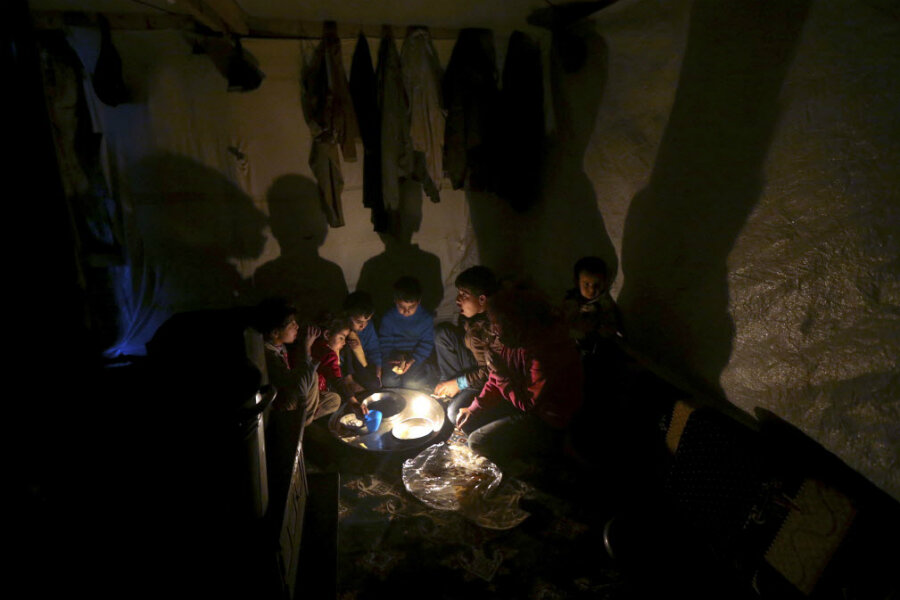United Nations: Brutal winter deepens crisis for Syria's refugees
Loading...
| WASHINGTON
For tens of thousands of Syrian refugees, the hardship and indignity of living in tents now pale – in what is proving to be an unusually harsh winter – in comparison to the threat that heavy snow will collapse those tents.
High winds, heavy snows, and freezing rain are disrupting normal life across a swath of territory from Turkey to Jordan and Israel. But for the one-third of Syria’s 23 million people displaced by their country’s civil war, the winter is a much bigger challenge.
The bitter cold and dampness are even proving deadly for a small but mounting number of children and other refugees. At least two refugee babies have died from the cold in camps in Lebanon, according to Lebanese news reports, while this week three Syrians – among them a child – trying to flee to Lebanon were caught in a storm and died from exposure.
Syrians displaced by the civil war have lived through three other winters, but conditions are worse this year for a perfect storm of reasons: There are more refugees, assistance from United Nations agencies and other humanitarian sources is less, and this winter is proving to be the harshest.
More than 3 million Syrians, or almost one-sixth of the prewar population, have fled to neighboring countries and now live either in organized camps – the more fortunate – or in makeshift squatter villages built of gathered wood, plastic, and corrugated metal. About a million Syrians now live in Lebanon, making up about a quarter of the population.
A study released this week by the chief UN refugee agency, the UN High Commissioner for Refugees, found that Syrians have now surpassed Afghans as the largest refugee population that UNHCR assists.
But agencies like UNHCR are being overwhelmed by a global spike in need for aid, spearheaded by the Syrian crisis. Last month the World Food Program (WFP) announced that unkept aid promises from donor countries meant it would have to suspend aid to 1.7 million Syrian refugees. The alarm spurred a sudden rush of giving and the suspension was called off – but food rations have still been cut to reflect the aid shortfalls.
And lack of funding has also forced lead humanitarian agencies to restrict their winterization programs and to retrench and focus on the most vulnerable refugee populations, such as children.
Despite the widely worsening human conditions, agencies like UNHCR, WFP, and UNICEF, the UN agency focused on children, are reporting some progress.
On Wednesday UNICEF and WFP announced they were joining forces to provide emergency winter cash assistance to 41,000 Syrian refugee children under the age of 14 in two giant refugee camps in Jordan. With news reports out of many camps showing children in snowy camps getting by with summertime clothing – some tromping through snow in flip-flops – the modest aid of about $20 per child is intended to allow families to buy their children coats and boots.
Other programs have focused on helping refugee families add a layer of protection – sometimes just another tarp – to their tents. But reports have mushroomed over recent days of tents collapsing from the weight of accumulating snow.
Another tricky problem for shivering refugee families is providing heat. Many families that fled Syria with some cash have seen that savings disappear just as winter was setting in. So now families are resorting to fires fueled with whatever can be scavenged, according to some aid workers, and that is posing new dangers in the tightly clustered camps.
One bit of progress emerging as part of the WFP’s winter assistance program is the expanding use of the food agency’s electronic voucher program. In teaming up with WFP, UNICEF decided to distribute the winter clothing assistance through the WFP’s e-card system, which allows registered families to access the assistance immediately.
The WFP’s deputy emergency coordinator for Jordan, Dorte Jessen, says the agency’s “e-card” program was developed as a system that other aid agencies could use.
“We are thrilled that UNICEF will be the first agency to reach Syrian refugees with their winterization program through WFP e-cards,” she said in a UN statement.
Aid experts generally concur that voucher systems are preferable to food handouts, where possible, for a number of reasons. They are more efficient than shipping in foreign-donated food, and they provide a sense of dignity to parents who can use the cards to purchase the food their family likes, and they can prepare it according to their family and cultural traditions.
The cards are used in local markets, and as a result aid local economies and can help reduce local populations’ opposition to hosting the refugee camps.








